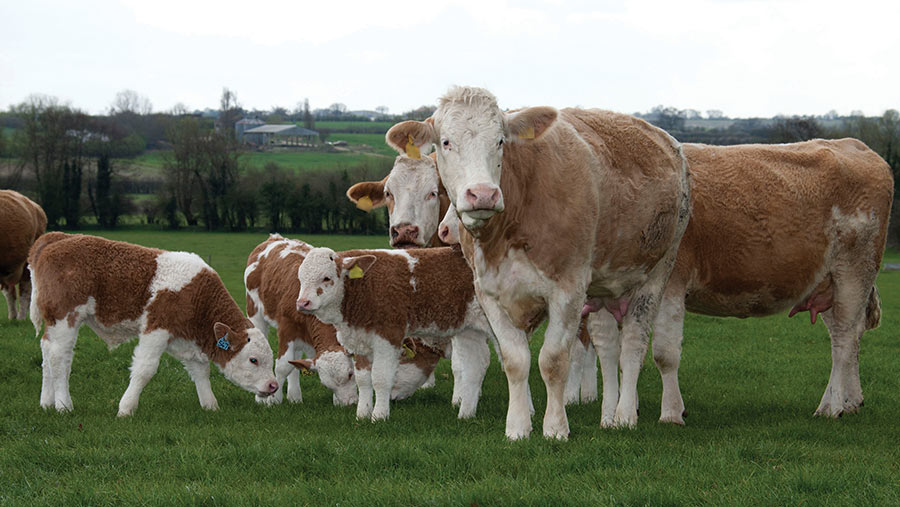Calf monitoring and health plans key to future performance
 © Tim Scrivener
© Tim Scrivener Some 90% of farmers want to make changes to improve the future sustainability of their youngstock management in the next 12 months, according to a Farmers Weekly exclusive survey.
Yet only 33% of those surveyed about their calf rearing said they had a routine disease prevention plan in place with their vet. Furthermore, just 23% of farms were weighing calves to track performance.
See also: What is holding back improvements in youngstock management
Farmers Weekly invited farmers, vets, and industry partners to a roundtable discussion in Shropshire hosted by FW’s Johann Tasker.
The aim was to find out how farming can improve the sustainability of beef and dairy calf management.
Take-home messages
- Use farm-specific KPIs
- Monitor and measure with your vet to identify areas for improvement
- Keep tasks such as weighing and recording simple, or they won’t get done
- Do a herd health plan and use it as a ‘working’ document, which is reviewed regularly
- Great scope for calf clubs led by vet practices to drive improvements
There are two key areas – monitoring performance and nutrition – where delegates believe change is required to deliver healthier, more efficient animals that are fit for purpose.
Catherine Pickford, Farmers Weekly’s 2022 Dairy Farmer of the Year, from Somerset, said not investing in heifers was short-sighted.
“My main challenge is keeping my costs low. It is the only thing I have any influence over. There are some things that can be cut back, but calves are not one of them,” she said.
“You should be concentrating on the next generation of your herd, and be doing anything you can to improve heifer health and survival rates.”
Delegates agreed that farmers needed to recognise the importance of good early-life management and how it influences an animal’s lifetime performance, regardless of whether it was destined for dairy or a beef.
For this to be realised, farmers have to monitor performance, said delegates.
Use KPIs to measure and monitor
However, 39% of survey respondents said they did not use KPIs to help inform management decisions. Of those that were recording KPIs, 33% were still using paper records.
Dr Jenny Gibbons from AHDB said as a starting point, each farm must identify KPIs that are specific to their farm.
“For a dairy farm, calving heifers at two years old will improve longevity and profitability. But you don’t calve down at 24 months by chance: you must monitor growth rates – and get heifers to their second and third lactation.”
Jenny referred to NMR data that showed 20% of heifers did not reach a second lactation. Yet, most heifers do not repay their rearing costs until their second lactation, she explained.
Shropshire dairy farmer Ruth Ashley, who milks 105 Holsteins robotically, is a keen advocate of monitoring herd performance.
She weighs calves regularly – at birth, eight weeks, at weaning, once after weaning and when heifers reach 11 months. This is to track daily liveweight gains and ensure heifers are on target to calve at two years.
Ruth said having protocols was essential to standardise jobs and ensure tasks, like weighing animals, were done consistently and regularly.
The important thing is that weights are taken in good enough time before breeding to allow farmers to make changes to nutrition, should it be required, said Volac’s research and development manager, Dr Jessica Cooke.
Catherine has realised feed cost savings from weighing: “This year, we have cut back slightly on what we were feeding our calves because the heifers were more than 60% of mature weight at service.”
Ensure nutrition allows for rumen development
Weighing acts as a critical checkpoint to ensure nutrition is adequate, and early life is when the calf is most feed efficient, added Jessica.
The majority (63%) of dairy farmers fed six litres of milk a day, with 25% feeding eight litres and only 5% feeding nine litres or more.
Jessica said feeding higher volumes of milk is fine providing it does not compromise starter intakes. By weaning, calves should be eating at least 2kg of concentrate daily
“They need to be eating a decent amount of starter for three weeks [before weaning] for the rumen to have sufficient time to develop.”
She advised farmers to weigh calves three to four weeks after weaning to check how successful weaning had been.
Work with your vet to improve animal health
Beef, suckler and dairy producers surveyed said they wanted to reduce disease incidence within the next 12 months, with pneumonia, scours and dead on arrival cited as leading causes of mortality on their farms.
Katie Fitzgerald, from Bishopton Vets in Ripon, Yorkshire, believes national calf mortality levels are still too high, which is counterproductive to improving sustainability.
She said herd health plans, which should include reviewing youngstock disease and vaccination protocols, are often perceived negatively by farmers and are seen as a tick-box exercise.
“Often, it is seen as a ‘must do’ and is not used as working, active document. When you make changes, the herd health plan should be reviewed,” she stressed.
Pneumonia was the number one cause of calf mortality, according to suckler, beef and dairy farmers surveyed.
Jessica said there was a place for calf discussion groups, spearheaded by vets, where farmers could benchmark against other businesses and find practical solutions to overcome health challenges.
Ruth has been carrying out lung scanning, before and after weaning, with Shropshire Farm Vets. This will help determine treatment protocols once she has a large enough dataset.
“We don’t want to be using lots more antibiotics, and I think [lung scanning] has a place as part of our arsenal to identify risk periods,” she explained.
Make the most of funding offers
Katie said the recently opened Defra funding for calf housing would be a welcome way to improve calf health and reduce disease.
“With poor cashflow it is really difficult for farmers to invest in buildings that don’t give them a return for two years, so it’s important Defra is supporting farmers to give calves the best start.”
She said farmers should also capitalise on the Animal Health and Welfare Pathway (AHWP), which offers funded, annual vet visits.
“Healthier calves grow up to become healthier cows that produce less methane than ill [cows],” pointed out Sabrina Jordan, product manager for Virbac UK.
Roundtable delegates
- Ruth Ashley, dairy farmer, Shropshire
- Catherine Pickford, dairy farmer, Somerset
- Sabrina Jordan, product manager, Virbac UK
- Mel Griffith, UK manager, Herdwatch
- Mark Smith, EMEA Beef director, Genus ABS
- Ian Watson, technical manager, Volac
- Jessica Cooke, research and development manager, Volac
- Katie Fitzgerald, Bishopton Vets
- Jenny Gibbons, Health and welfare scientist, AHDB

Delegates at the roundtable © Richard Stanton
About the Calf Sustainability project
Livestock farmers in the UK are facing increasing pressures for a number of reasons. This project aims to open up the conversation around best practice to help producers ensure a sustainable future for all their businesses.
Farmers Weekly worked with seven partners to help make this possible.
